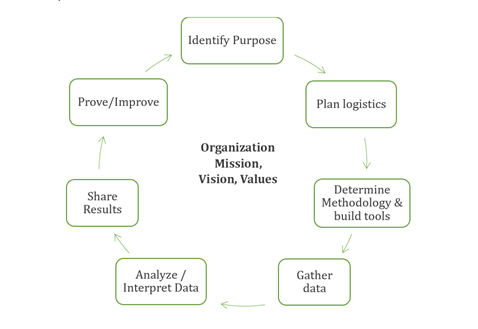Whether for the purposes of accountability or improvement, assessment should be an iterative process, in which results are used to implement change, then re-assess impacts. Framing projects within a standardized cycle provides context for the similarly iterative process of collaboration between Student Affairs Departments and Assessment & Research. The following framework is adopted from Yousey-Elsener (2013).

Phases
An assessment project typically starts with a purpose, broadly to improve a certain program or prove its value. Purpose informs the logistics of the project, such as resources and timeline. Logistical factors in turn inform the methodology, including instrumentation and data collection methods. Once these first planning phases are complete, new and/or existing data is collected. Assembled data is analyzed and interpreted, sometimes identifying the need for further data collection. Results are organized into a format relevant for stakeholders. If the purpose is accomplished, results are utilized to implement change, whether improving a program or securing new resources. Finally, the effects of this change should be assessed, starting the cycle over again.
The Core
The idea of the core is to remember the mission throughout the cycle. Purpose should clearly come from the mission. However, a department’s mission should also influence decisions about methodology, interpretation, and other phases of the cycle. We’ve expanded the idea of the mission as core to incorporate Simon Sinek’s Golden Circle. Sinek proposes that inspiration comes from a core understanding of why an organization exists. From the why should come how the organization accomplishes what they do in pursuit of the why. This core is ideally evidenced in theory and research and mapped up to the institutional mission and strategic planning.
Application
When Assessment and Research consults with a department, we will organize action steps along this assessment cycle in order to share a consistent context. All projects should, before collecting data, have mutually agreed upon action items proposed for each phase of the cycle. Adaptability will likely be needed somewhere in the process, but not at the expense of intentionality. Beyond the application of the assessment cycle to departmental projects, SAAR’s educational programming will be designed and marketed to address different phases of the assessment cycle. In this manner, we can collaboratively track progress in building Division capacity to comprehensively assess our enrichment of student learning.
The Assessment Cycle
• Identify Purpose – what are the goals for your assessment? What questions do you want to answer? What decisions will these answers inform? What change do you want to implement?
• Plan Logistics – what are the limitations on your assessment, including financial and human resources? Is there a particular deadline or deliverable?
• Determine Methodology & build tools – how can you best meet the purposes of the project? What kind of assessment? What kind of tool should be used?
• Gather Data/Evidence – collect existing or new relevant information including numbers, expert opinions, stories, observations, and documents.
• Clean, Analyze, and Interpret – review and prepare your evidence for efficient and valid analysis, address purposes and integrity of findings during interpretation.
• Share Results – organize findings into format appropriate for necessary stakeholders.
• Prove/Improve– utilize findings to maintain or improve a desired outcome, pitch for resources, etc.
